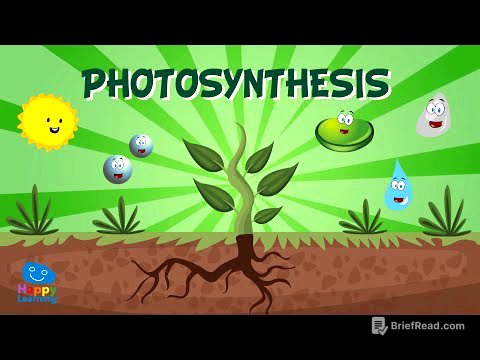TLDR;
The lecture explores the fundamental role of light in the universe, arguing that it's not just a means of observation but a necessary component for the existence of reality itself. It explains how light, or electromagnetism, arises from the interplay between nature's universal speed limit and its preference for symmetries.
- Light is essential for the existence of reality, not just for observing it.
- Electromagnetism, or light, emerges from the tension between the universal speed limit and nature's love for symmetries.
- The existence of light ensures that symmetries are maintained throughout the universe without violating the speed limit.
Introduction: The Ubiquity and Necessity of Light [0:16]
The speaker introduces the concept of light and its fundamental role in our ability to perceive the world. While we commonly understand light as illumination, the lecture aims to explore a deeper question: Could the universe exist without light? The speaker posits that light is not merely a tool for observation but a necessary ingredient for the very existence of reality. The lecture will explore the properties of light to understand why it exists and its importance in the universe.
Light in the Universe [1:11]
Despite the perception of outer space as pitch black, the universe is filled with light, specifically a very ancient, red light that is not visible to the human eye. This light, known as the cosmic microwave background, permeates the cosmos. The question is posed: could the universe have existed without light? The speaker argues that the laws of physics and reality itself depend on the existence of light.
Light as a Mediator in Physics [3:31]
The lecture introduces the idea that light acts as a mediator between different fields of physics that may not always align. Nature has various parts of physics with their own laws that work individually, but they don't always work well together. Light is presented as a necessary ingredient in the universe, ensuring that these individual parts can coexist harmoniously. Two key aspects of physics are highlighted: nature's universal speed limit and its love for symmetries, which often conflict.
The Universal Speed Limit and Symmetries [5:31]
Nature operates under a universal speed limit, approximately 300,000 kilometers per second, which cannot be surpassed. Additionally, nature exhibits a preference for symmetries, aiming to maintain uniformity. These two principles can conflict, requiring a mediating force. An example is given with a cup of tea cooling down to room temperature, where heat transfer ensures temperature symmetry while adhering to the speed limit.
What is Light? A History Lesson [10:39]
The lecture transitions into a history lesson, exploring how light was discovered through investigations into electricity and magnetism at the Royal Institution. Scientists like Michael Faraday and James Clark Maxwell uncovered the relationship between these phenomena, culminating in Maxwell's equations. These equations demonstrate that electric and magnetic fields are interconnected, with changes in one field creating the other.
Electricity and Magnetism [12:32]
A demonstration using a Van de Graaff generator illustrates the principles of electricity, showing how charged particles create electric fields. Similarly, magnets demonstrate magnetic fields. The key discovery was that electric fields and magnetic fields are not independent but are related, meaning electricity can be turned into magnetism and vice versa.
Experiments Demonstrating Electromagnetism [16:25]
Experiments are conducted to demonstrate the relationship between electricity and magnetism. A compass is used to show that electricity can be turned into a magnet by running a current through a wire, which affects the compass needle. Conversely, moving a magnet can generate electricity, as shown by a volunteer blowing on a turbine connected to a light bulb.
Maxwell's Discovery: Light as Electromagnetism [22:08]
Building on these experiments, the lecture explains how James Clerk Maxwell discovered that light is essentially a wobbling of electromagnetism. Maxwell's equations revealed that oscillating electric fields create magnetic fields, and vice versa, resulting in a self-propagating electromagnetic wave that travels at 300,000 kilometers per second—the speed of light. This discovery unified the understanding of light, electricity, and magnetism.
Building a Universe Without Electromagnetism [25:14]
The lecture returns to the original question: Could a universe exist without electromagnetism? The approach involves constructing a hypothetical universe with space, time, and particles but without electric or magnetic fields. The goal is to demonstrate that the fundamental laws of physics necessitate the existence of a universal speed limit and symmetries, which ultimately lead to the emergence of electromagnetism.
The Universal Speed Limit from Balloon Physics [28:11]
The existence of a universal speed limit is derived from "balloon physics." By observing that a balloon maintains a constant shape, it's inferred that the pressure inside and outside the balloon must be equal. This leads to a broader principle: if two systems agree on a third, there must be a shared property between them. This concept is then extended to the principle of relativity, demonstrating that the speed of light is a universal constant agreed upon by all observers, regardless of their relative motion.
Symmetries and the Need for New Particles [43:51]
The lecture introduces the concept of symmetries using colored wheels, illustrating that nature often remains the same even when certain properties are swapped or rotated. However, maintaining these symmetries across the universe requires information to travel between different points. Because this cannot happen instantaneously due to the universal speed limit, new particles are needed to carry this information. These particles, known as gauge bosons, ensure that symmetries are upheld without violating the speed limit.
Quantum Mechanics and the Origin of Light [53:45]
To understand the symmetry that gives rise to the photon, a sprinkle of quantum mechanics is introduced. Quantum mechanics dictates that particles have wave-like properties, and rotating these waves should not change the particle's mass or position. This symmetry requires a particle to transmit information about the rotation across the universe. The formulas describing these particles match Maxwell's equations, demonstrating that electromagnetism arises from the quantum mechanical symmetry of rotating particles.
Conclusion: The Necessity of Light [58:01]
The lecture concludes that a universe without light, or electromagnetism, is impossible. Light emerges as a necessary consequence of nature's love for symmetries and the existence of a universal speed limit. Photons, the particles of light, are nature's way of maintaining symmetry throughout the universe without breaking the speed limit. The existence of light allows us to study and appreciate the universe, making it a fundamental aspect of reality.









